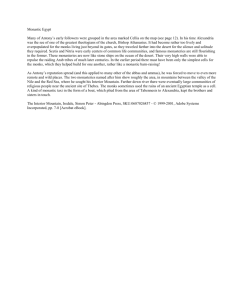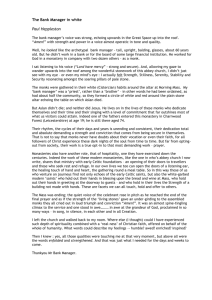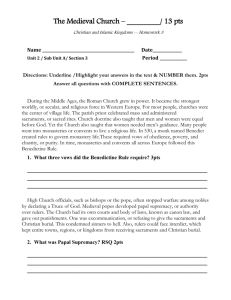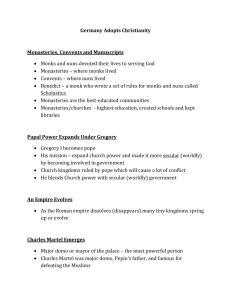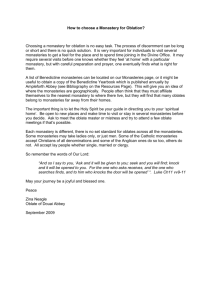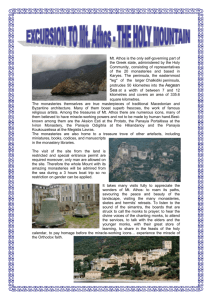Monasteries - WordPress.com
advertisement
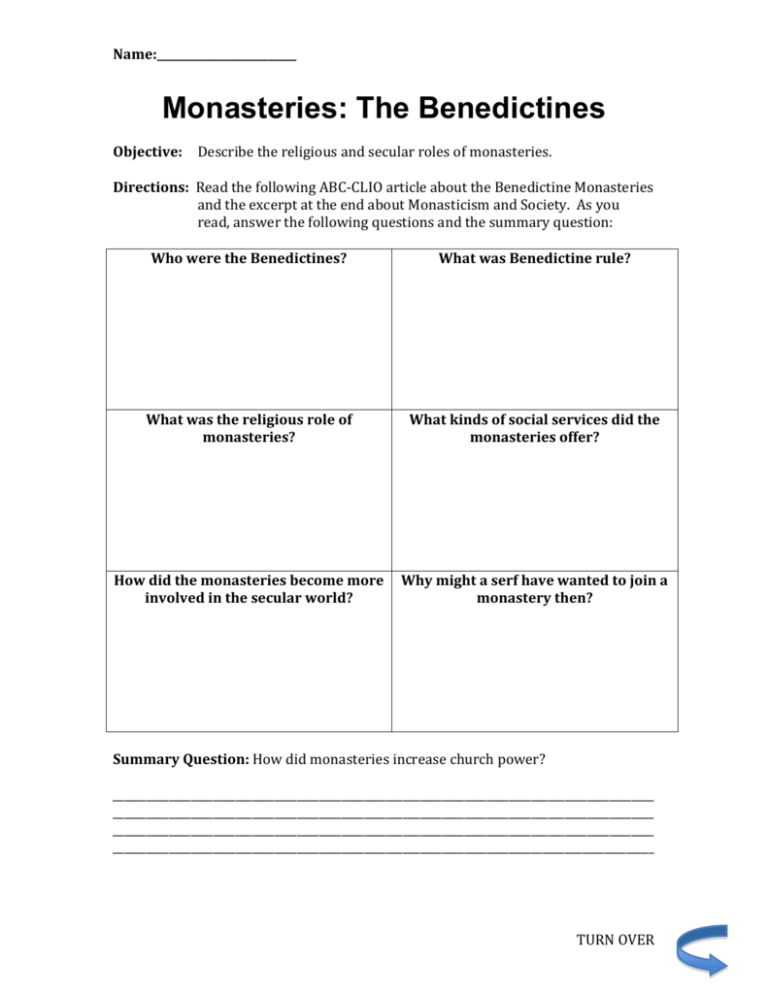
Name:_________________________ Monasteries: The Benedictines Objective: Describe the religious and secular roles of monasteries. Directions: Read the following ABC-CLIO article about the Benedictine Monasteries and the excerpt at the end about Monasticism and Society. As you read, answer the following questions and the summary question: Who were the Benedictines? What was Benedictine rule? What was the religious role of monasteries? What kinds of social services did the monasteries offer? How did the monasteries become more involved in the secular world? Why might a serf have wanted to join a monastery then? Summary Question: How did monasteries increase church power? _________________________________________________________________________________________________ _________________________________________________________________________________________________ _________________________________________________________________________________________________ _________________________________________________________________________________________________ TURN OVER Name:_________________________ The Benedictines The Benedictines were the oldest order of monks in Western Europe during the Middle Ages. They followed Benedict of Nursia's Benedictine Rule, written in the mid-sixth century and based upon monastic experience in the Eastern Roman Empire. The rule, or constitution, was intended to be flexible and moderate, so that each monk could glorify God and achieve his own individual salvation. By 800, the Benedictine Rule dominated all other monastic rules in Western Europe. Benedict had established his original monastery at Monte Cassino in Italy ca. 530. His original group of followers were laymen seeking to escape the world. The monks made vows of stability, reformation of life, and obedience. A daily routine was fixed for the monks, with a balance between work and prayer and moderation in all things as its guiding light. Benedict intended for the monastery to be self-supporting in order to minimize contact with the outside world. Contemporary observers referred to Benedictines as the "black monks" because of their robes; other orders wore different colored robes, like the Cistercians with their white robes. After the Lombards sacked Monte Cassino ca. 589, the Benedictines fled to Rome. Many were sent by the popes to regions throughout Western and Eastern Europe to establish new monasteries and to convert the pagan peoples there. Although each monastery followed the Benedictine Rule, each was independent. Their roles also changed as society became more feudal. People began to view the monks as defending them from evil and the monks' prayers as providing spiritual salvation for the general population. The monks were expected to work not just for their own salvation but for everyone's. The monasteries also prospered under the feudal system and became landlords as time went by. Feudal commitments, such as the need to provide knights for greater lords, drew the monasteries into more worldly affairs. As the general level of learning declined, Benedictines often filled such roles as clerks, financial officers, and architects. The move away from purely spiritual concerns to more worldly cares caused a decline in the spirituality in the monasteries. Servants and an aristocratic lifestyle was common among Benedictine monks by 1000. Before that date, the children of the poor were often admitted to the order. By the High Middle Ages, membership was most often limited to members of the nobility who could pay an expensive dowry for admission. Convents were established for women interested in the monastic life, and they also followed the above pattern. Benedictine monasteries provided centers of learning for much of the Middle Ages. Benedict had called his monastery a school for God's service. On a practical level, the monasteries soon developed schools for young monks and for the children of the local nobility. They also became centers for making copies of existing books. In addition, the monks produced commentaries on scriptures, biographies, histories, and scientific and mathematical treatises. Beginning around 1200, the Benedictine monasteries went into a decline. Many of the causes were economic. Incomes declined, while expenses remained high. Besides the aristocratic lifestyle of the monks, costs included such charitable work as distributing bread to the poor. Building programs to enhance the beauty of the monasteries proved to be a drain on resources as well. The individual monasteries resisted efforts to centralize the order and reform many of its practices. Competition from growing numbers of educated laymen, as well as advances such as the printing press, reduced the monks ability to compete economically. The establishment of dynamic new orders such as the Dominicans reduced the number of men and women joining Benedictine monasteries as well. Although the Benedictines had provided important service in maintaining Christianity and learning during the Middle Ages, their importance declined in the modern era. MLA Citation "Benedictines." World History: Ancient and Medieval Eras. ABC-CLIO, 2013. Web. 22 May 2013. TURN OVER
